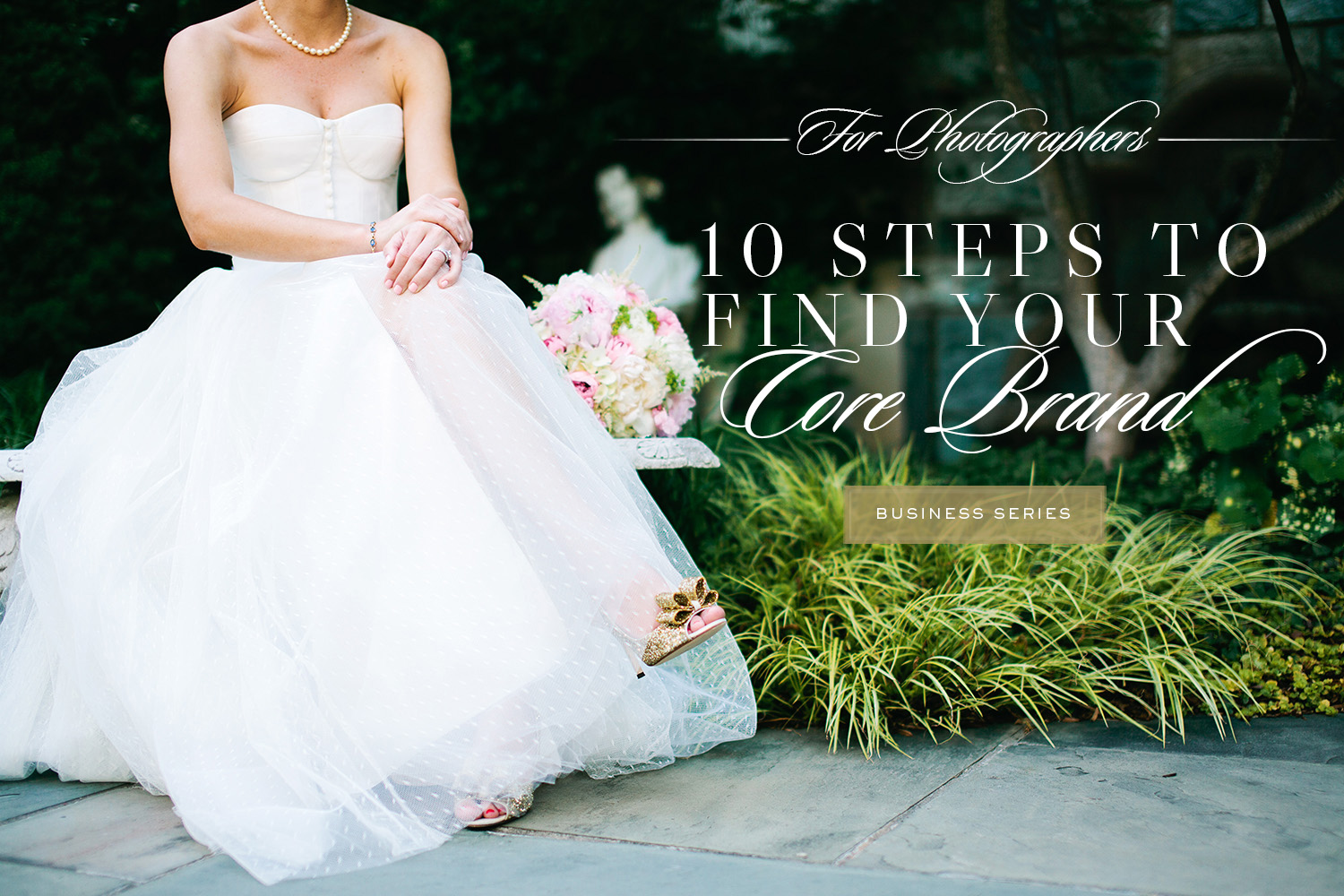
Yesterday I wrote a post about the difference between a visual brand and a core brand. The VISUAL BRAND is a logo, color scheme, visual identity, means of marketing, etc that identifies you with your business. The CORE BRAND is the heart and soul of the business— the way it operates, the owner’s beliefs that influence business methods, ideals & aspirations, etc. While the visual brand may change (even drastically) over time, the core brand stays, for the most part, the same. It may mature over time, as the owner himself matures, but it’s essence, the part that makes it unique, that will likely stay the same, regardless of the changes to it’s external expression.
But how does one come up with a CORE BRAND? How do you find it? Here are 10 Steps:
1. Quiet the Noise.
Take a day, or even an afternoon, and go some place where there is no Internet, and do some soul searching. Why turn off the Internet? Nicholas Carr wrote an article in The Atlantic that perhaps best summarizes what the Internet is doing to its users: “For me, as for others, the Net is becoming a universal medium, the conduit for most of the information that flows through my eyes and ears and into my mind…And what the Net seems to be doing is chipping away my capacity for concentration and contemplation. My mind now expects to take in information the way the Net distributes it: in a swiftly moving stream of particles. Once I was a scuba diver in the sea of words. Now I zip along the surface like a guy on a Jet Ski.” (emphasis ours). He also quotes playwright Richard Foreman, who said, “We are the pancake people…spread wide and thin as we connect with that vast network of information access by the mere touch of a button.”
Taking time to quiet outside noise lets us hear our own heart and soul, and that is vitally important when trying to define your CORE BRAND. It may feel uncomfortable, but I can assure you it is necessary.
One note, however— ambient noise can help with concentration, which is a case for working from coffee shops! According to a peer-reviewed study out of the University of Chicago, “A moderate level of ambient noise is conducive to creative cognition.” In a nutshell, this means that being slightly distracted actually frees our brain to be more creative! That’s why we come up with our best ideas in the shower, or when we’re doing dishes or something like that. In a coffee shop, the buzz of conversation and quiet clatter of dishes distract us a tiny bit, allowing our creative juices to flow!
Pro tip: if you work better at home, but still want to tap into that half-distracted creativity, try using an app such as Coffitivity to “fake” coffee shop noise!
2. Write Out Everything That’s Important to You
Some people suggest finding three words that best summarize your business. Others suggest writing a “mission statement” or “purpose statement” about who they are and what they’re doing. I wrote a list of Core Beliefs that I use as a filter for every business decision.
You? Just write.
Fill up pages and pages if you have to, and remove the stress of trying to narrow things down too much. Think primarily about business, but don’t leave your personal life out of it— if you’re self-employed, the lines are really blurry here. Ask: “Am I putting this out there because I think it’s expected? Am I afraid to put this out there because I think it sounds cliché?”
3. Ask, “What do I like doing, and why? What do I want to do more of?”
Simply stating what we like and what we’re good at is so simple that we often overlook it. But God created every person with unique gifts and pleasures, and it’s not surprising that the things we like and are good at are also the things that touch our core.
4. Analyze the last 10 weddings/portrait sessions/clients that you loved.
Why did you love them? Which ones fit you most? What about those clients or events made you say “yes”? Notice your emotional response to things, and find common denominators. Ask: “Where do I thrive? What makes me happy?
Note: if you can’t find any in the last 10, think back as far as necessary to find that enjoyable one.
5. Describe your ideal client/shoot.
This is different than above— most of us have had shoots or clients that had elements of our ideal. If you could script the perfect wedding or portrait shoot, what would it look like, and why? If you could create the perfect client, what would they be like, and why? Where would they shop? How would they view the world? What would they value?
If you want a great example of this ideal, look at Justin & Mary Marantz’s “Are you a J & M Client” page here.
6. Ask “What do I dislike doing, and why? What work would I be happy to never do again?”
Why did you dislike it? What turned you off?We can learn as much, if not more, from what we dislike as we can from what we like. Many people tend to shy away from these questions from fear of being overly negative, but it’s important to learn to identify negatives as well as positives in situations— especially in situations you can control. You don’t like photographing sweet 16 parties or anniversary celebrations? Well, guess what— you don’t have to! You own your own business for a reason. Don’t be afraid to be vocal about what kind of business you want to have. That’s why I stopped doing family portraits. I love children, and I’m fairly good with them. But there is nothing more stressful to me than a family portrait session. I’ll take back-to-back weddings any day over a children’s session! I’m not good at them, and I dislike them. So I don’t offer them.
And don’t only think in terms of “likes and dislikes.” Also think in terms of momentum and stagnation. What work propels your business forward? What work (regardless of how much you enjoy it) slows your momentum and pulls you back? For me, that was real estate photography. I looooooooove photographing real estate (1. because I secretly want to buy and sell houses all the time, and 2. because I dream of flipping houses someday), and I made it a successful part of my business for several years. But it took too much of my time away from my primary work— weddings and engagements. I calculated that I spent about 65-70% of my time and attention during the week on work that only made up 10-12% of my overall income. Not a great ratio. So I had to stop, because it slowed my momentum.
7. Ask, “What do I want my business to stand for?”
Think in terms of the ideal client, the business reputation you build, the work you produce, and how much time and energy you want to pour into your business. Think 50 years down the road, at your retirement ceremony— what do you want people to say? How do you want your business to be spoken of?
Every person leaves a legacy. What will yours be?
8. What do you want your product to communicate?
To your client— “Your wedding matters because its the most important day of your life, and I value marriage and want to support you as you enter it” VS. “Your wedding pays my bills and/or for that snazzy vacation that I’m taking this Summer. Thanks for being a heavy hitter.”
To outside consumers— “My business is about my clients. They are my priority, and I will go to the end of the earth to make sure they’re happy. I take my job seriously, and genuinely care about the people I work for” VS “My business is about making a name for myself. I care more about my brand than about my clients. This job is just a thing I do.”
To your family— “I work to contribute to the good of our family. You are always my priority, and I’m careful with my time to make sure I’m taking care of business while making sure that you always know that you come first” VS “Work is my life, and you’re just going to have to get used to me working all the time. It’s my identity.”
Figuring out what you want your work and your product to communicate helps to filter many of our decisions, and helps to define our Core Brand.
9. Think 10 years ahead, down the road.
What do you want to be doing in ten years? More importantly, who do you want to be? Write it down, and then figure out the steps needed to make that happen. What can you do today to start this goal? What can you do next month? Make a plan.
10. BHAG (Big, Hairy, Audacious Goals)
Dream BIG. Dreaming, especially the wild-and-crazy, no-one-will-ever-believe-it’s-possible dreams are healthy for the soul.
One, because of what I affectionally refer to as the Enchanted Wood Effect, which comes from a quote by C. S. Lewis in the book, Of Other Worlds: Essays and“[The fairy tale] stirs and troubles [the child] (to his life-long enrichment) with the dim sense of something beyond his reach, and, far from dulling or emptying the actual world, gives it a new dimension of depth. He does not despise the real woods because he has read of enchanted woods: The reading makes all real woods a little enchanted.” In the same way, dreaming big, crazy, out-of-this-world dreams adds just a bit of magic to every step that we take to achieve them.
Two, because these dreams stretch us to reach higher than we would’ve otherwise dared. So write them down! It will push you to actually achieve some of them! Write down at least three dreams that seem impossible. Why do you want to accomplish them?
11. BONUS!!
What one thing must I do?? What, if left undone, will make all other things obsolete?
Now we take all of this information and try to find the common denominators, the “golden thread” that ties everything together. Ask one big question—WHY DO I DO WHAT I DO??
Note: These questions take a lot of time. You may not be able to sit down and figure all of this out in one afternoon at a coffee shop, especially if you’re not naturally given to introspection. But let me assure you— the work you put into it, and your patience in the process, will pay off.

Love this Sarah. Thanks for sharing, so on point !!!
Wow– this was absolutely incredible and so helpful!
Thank you SO much for this, Sarah!! This is e.x.a.c.t.l.y what I needed to read today!
Great points, Sarah! I love this!
[…] for them. I talk about this all the time, right? The importance of having a plan in place, and a purpose behind that plan, and setting goals to help you succeed? Even I, “Miss Intentionality” needs that […]
[…] 10 Steps to Find Your Core Brand […]